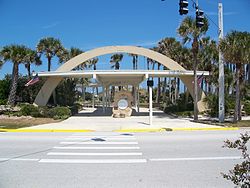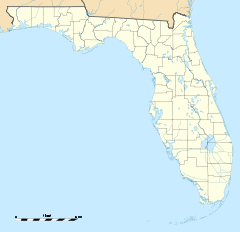- Marineland of Florida
-
Marine Studios

Location: Marineland, Florida Coordinates: 29°40′6″N 81°12′46″W / 29.66833°N 81.21278°WCoordinates: 29°40′6″N 81°12′46″W / 29.66833°N 81.21278°W Built: 1937[2] Architect: John Walter Wood and M.F. Hasbrouch[2] Architectural style: Moderne style[2] Governing body: Georgia Aquarium NRHP Reference#: 86000831[1] Added to NRHP: April 14, 1986 Marineland of Florida (usually just called Marineland), one of Florida's first marine mammal parks, is billed as "the world's first oceanarium". Marineland functions as an entertainment and swim-with-the-dolphins facility, and re-opened to the public on March 4, 2006 (charging the original 1938 admission price of one dollar).
On the first day of 2011, the park was purchased by the Georgia Aquarium for a reported 9.1 million dollars.[3] The seller was Jim Jacoby, an Atlanta developer and member of the Georgia Aquarium board of directors, who bought the park in 2004 and redeveloped it.
History
Marineland was first conceived by W. Douglas Burden, Cornelius Vanderbilt Whitney, Sherman Pratt and Ilya Tolstoy as an oceanarium that could be used to film marine life. A site was selected on the Atlantic Ocean south of St. Augustine, eventually known as the town of Marineland. The site of Marineland is within a 20,000-acre (81 km2) grant given to London barrister Levett Blackborne in 1767. The well-connected Blackborne, grandson of Sir Richard Levett, Lord Mayor of London, never settled his grant (nor even visited Florida), and eventually Blackborne's plantation was regranted to John Graham, a Georgia Loyalist fleeing the Revolutionary War.[4] Ultimately, the land that is today Marineland was broken up over the years into smaller parcels.
Financing and construction presented challenges as Marineland was the first attempt at capturing and sustaining sea creatures. These challenges were overcome. Construction and engineering was carried out Arthur Franklin Perry Co. of Jacksonville. On June 23, 1938, "Marine Studios" (the name "Marineland of Florida" would later be adopted) began operations with its main attraction as a bottlenose dolphin. Unexpectedly, over 20,000 tourists clogged Highway A1A to visit the new attraction. For many decades Marineland consisted of not only the oceanariums but several amenities including a motel (Marine Village Court, Marineland Motel and Quality Inn/Marineland); Dolphin Restaurant and Moby Dick Lounge; Periwinkle Snack Bar and Sandpiper Snack Bar; Marineland Marina; plus fruit shop and gift shop; and a pier at the north end of the facility. A Texaco service station was adjacent to the Periwinkle Snack Bar and Greyhound Bus Lines stopped regularly during its St. Augustine to Daytona Beach run.
The total property area consisted of 125 acres sandwiched between the Atlantic Ocean and the Intracoastal Waterway. Originally planned for the St. Augustine area, residents of that community did not look favorably on the attraction being located there; thus the new site south of Matanzas Inlet was chosen.
Having the grandson of Leo Tolstoy involved in the project helped Marineland become a very fashionable destination in its early days, prompting writers Marjorie Kinnan Rawlings, John Dos Passos, and Ernest Hemingway to visit Moby Dick's Bar located there. Ms. Rawlings was married to Norton Baskin who at one time (1950s/early 1960s) was the operator/manager of the Dolphin Restaurant/Moby Dick Lounge. The park's facilities were very popular with tourists and also used for numerous movies, including Creature from the Black Lagoon (1954) and Revenge of the Creature (1955). Trained dolphins became an additional attraction in the early 1950s as Marineland became one of Florida's major attractions, attracting over 900,000 visitors per year with peak attendance in the mid-1970s The opening of Walt Disney World Resort in 1971 giving a major boost to the attraction's annual attendance. However, Sea World's entry into the Florida market eventually had a very negative impact on Marineland from the late 1970s through the 2009. Many publications unfortunately note the peak attendance at 300,000 which is erroneous. The break-even admission point was 400,000 even during the 1950s.
Cornelius Vanderbilt Whitney who was the major stockholder of the private company opted to sell the marine park in the mid-1980s to a group of St. Augustine businessmen. With declining attendance the norm, the group was unable to meet its loan payments and the attraction was again put on the market. Ownership change was the norm from that point.
Eventually, the maintenance demands of the old park became too costly for the real estate investment group who owned it at that time. The facility began to sink into disrepair as the owners desperately sought a buyer. Finally, through a convoluted deal involving junk bonds, the property was sold. The buyers planned to build time-share condominiums on most of the ocean hammock land but were unable to bring the plan to fruition. This effort resulted in bankruptcy for the buyers. In addition, the already-strapped oceanarium had been reconfigured as a non-profit foundation as part of the sale and was responsible for its own sustenance as well as repayment of the bond issue. Needed monies were not invested in repairs, and the shabby condition of the park offended even the most loyal fans. With no direct ownership, no funding, and the financial burden of bond interest payments, employees were left to cope with equipment failures, no marketing, loss of credit, bounced paychecks, government inspections and the custodianship of the marine mammals, fish and birds. During this era, many devoted individuals and businesses contributed materials and services to help employees keep the place going. In the end, the foundation repaid the bondholders pennies on the dollar, a large part of Marineland's dolphin population was sold off to Orlando, and the current owner came in and picked up the pieces.
Hurricanes Floyd and Irene in 1999 forced the park to close for two months. In 2003, all of the park buildings west of Highway A1A were demolished leaving only the original structures along the Atlantic Ocean. In 2004, the park closed completely for renovations, and re-opened on March 4, 2006.
During the renovations the original 1938 Circular Oceanarium (400,000 gallons) and Rectangular Oceanarium (450,000 gallons) were demolished. The age of the Dolphin Show at Marineland is now over as the park reopened as a hands on educational facility. Future plans for the area include a condo development on former park lands. The rest of the old Marineland property wound up in the hands of Flagler County and now make up the River to the Sea Preserve one of the County's many parks.
With a gift from Cornelius Vanderbilt Whitney of slightly more than 3 acres (1.2 ha) of land together his donation of about half of the total constructions costs, on January 30, 1974, the University of Florida opened the Whitney Marine Laboratory adjacent to Marineland. This laboratory's purpose was the experimental study of marine animals but was separate from the lab that was once operated by Marineland. Marine Studios through its Research Facility contributed greatly to the understanding of porpoises from 1938 thanks to Arthur McBride, Forrest Woods and other marine biologists. The staff at Marineland was a "first responder" for hundreds of whale strandings along the southeastern Atlantic Coast during its existence.
Marineland had three bottlenose dolphins born at the newly constructed Dolphin Conservation center in July 2008. Two of them were males and one was female. The calves were named in November 2008.
In January 2011, Marineland was sold yet again and is currently being operated as a subsidiary of the Georgia Aquarium.
References
- ^ "National Register of Historical Places - Florida (Fla.), Flagler County". National Register of Historic Places. National Park Service. 1986. http://www.nationalregisterofhistoricplaces.com/FL/Flagler/state.html. Retrieved 4 January 2010.
- ^ a b c "Marine Studios". Florida Heritage Tourism Interactive Catalog. Florida's Office of Cultural and Historical Programs. http://www.flheritage.com/services/sites/fht/record_t.cfm?ID=272&type=c&index=18. Retrieved 17 August 2007.[dead link]
- ^ Ruggieri, Melissa (3 January 2011). "Georgia Aquarium buys Florida's Marineland". ajc.com. Atlanta Journal-Constitution. http://www.ajc.com/business/georgia-aquarium-buys-floridas-794147.html. Retrieved 4 January 2011.
- ^ "Town of Marineland Sustainable Tourism Comprehensive Plan Element". law.ufl.edu. University of Florida Conservation Clinic. http://www.law.ufl.edu/conservation/pdf/marineland.pdf. Retrieved 4 January 2010.
External links
Zoos, aquariums, and aviaries Types of zoos Conservation Lists Animals Other topics - Animals in captivity
- Animal training
- Behavioral enrichment
- Captive breeding
- Frozen zoo
- Immersion exhibit
- Nocturnal house
- Wildlife conservation
- Zookeeper
- Zoology
- Portal
- Project
- Category
- Commons
Aquariums & Zoos of Florida Aquariums Zoos - Brevard Zoo
- Butterfly World
- Center for Great Apes
- Central Florida Zoo and Botanical Gardens
- Dade City's Wild Things
- Flamingo Gardens
- Gulf Breeze Zoo
- Jacksonville Zoo and Gardens
- Key West Butterfly and Nature Conservatory
- Lion Country Safari
- Lowry Park Zoo
- Naples Zoo
- Palm Beach Zoo
- Santa Fe College Teaching Zoo
- St. Augustine Alligator Farm Zoological Park
- Zoo Miami
Animal Theme Parks U.S. National Register of Historic Places in Florida Lists by county Alachua • Baker • Bay • Bradford • Brevard • Broward • Calhoun • Charlotte • Citrus • Clay • Collier • Columbia • DeSoto • Dixie • Duval • Escambia • Flagler • Franklin • Gadsden • Gilchrist • Glades • Gulf • Hamilton • Hardee • Hendry • Hernando • Highlands • Hillsborough • Holmes • Indian River • Jackson • Jefferson • Lafayette • Lake • Lee • Leon • Levy • Liberty • Madison • Manatee • Marion • Martin • Miami-Dade • Monroe • Nassau • Okaloosa • Okeechobee • Orange • Osceola • Palm Beach • Pasco • Pinellas • Polk • Putnam • Santa Rosa • Sarasota • Seminole • St. Johns • St. Lucie • Sumter • Suwannee • Taylor • Union • Volusia • Wakulla • Walton • Washington

Lists by city Other lists Categories:- Buildings and structures in Flagler County, Florida
- Dolphins
- Oceanaria in the United States
- National Register of Historic Places in Florida
- Visitor attractions in Flagler County, Florida
Wikimedia Foundation. 2010.


